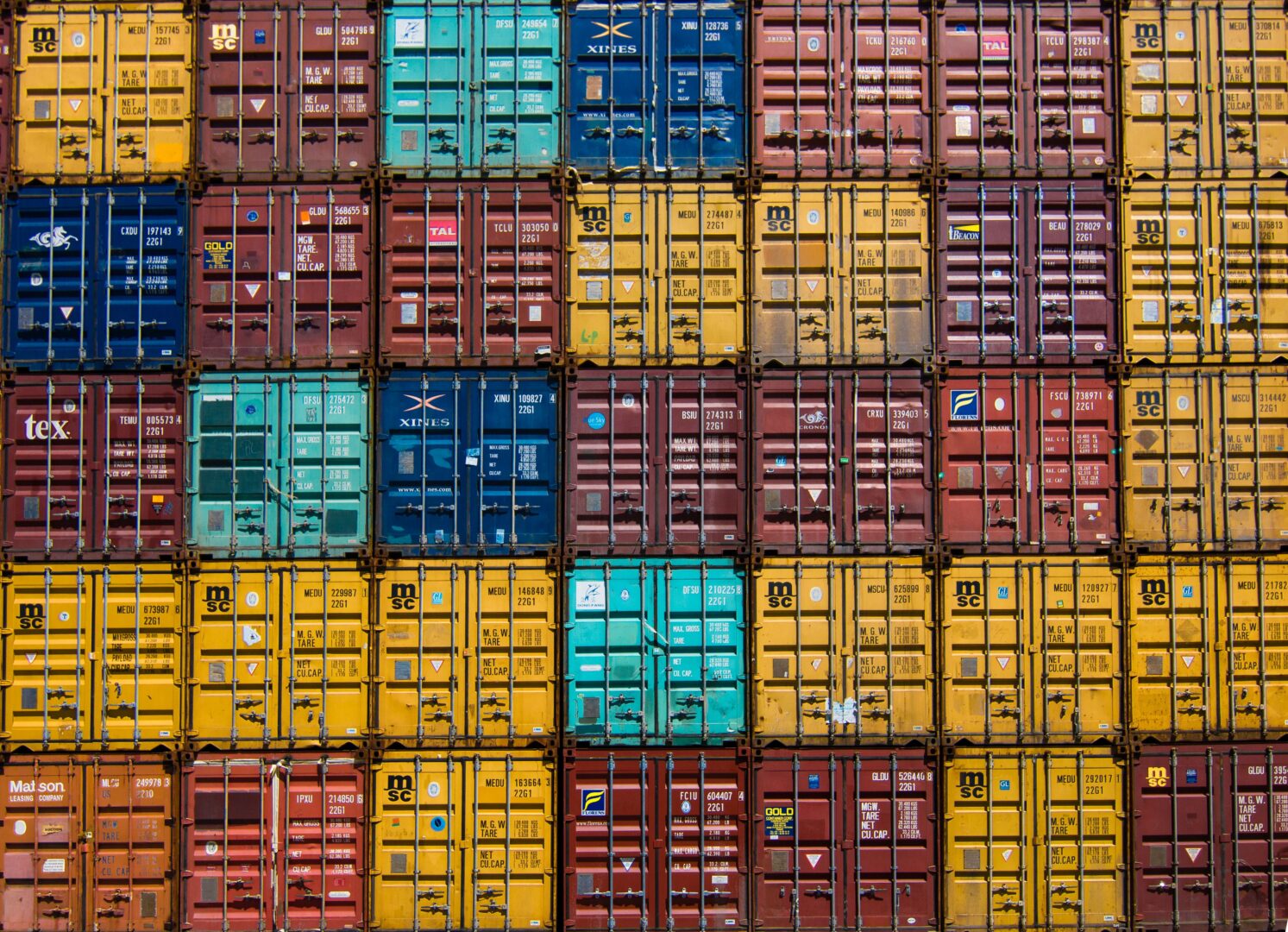
RFID: Yesterday’s blockchain
Blockchain is a hot topic these days in supply chain circles. Starting with a near-apocryphal story of a Walmart executive frustrated by the company’s lack of traceability, blockchain is being touted as the future of supply chain. The array of potential applications is dizzying, covering traceability, customs formalities, international shipping documentation, safety and sustainability data, and supply chain financing. Some of the media coverage reporting is so breathless it borders on hype.
Much of this seems oddly familiar: a new technology that will revolutionize supply chains through improved visibility, data reliability and productivity. It is reminiscent of the advent of RFID (radio frequency identification) about 15 years ago.
The comparisons go further than excited predictions or retailers like Walmart making headlines with pilot implementations. Just as RFID was beset by competing standards for hardware, software and data management, blockchain today has a variety of platforms coming online, each hoping to win the battle of becoming the universal standard. We look back to a time when RFID was the technology of the supply chain future, explore what really transpired and reflect on the lessons for today.
RFID origins
RFID began attracting attention in the early 2000s. It offered the promise of significant benefits in productivity and visibility, mostly as a replacement to bar codes. The Economist hailed RFID as the “the best thing since the bar code” while others proclaimed it “the biggest thing since Y2K.”
RFID tags could be read without having a line of sight on the bar code and the information on the tags could evolve at different stages in the supply chain. This would provide item-level accuracy with considerably less effort and more precision. Advocates promoted the potential to improve demand planning and on-shelf availability, dampen the bullwhip effect, and lower inventories, costs and stock outs.
Recently, we toured of the flagship store of a luxury retailer. The retailer was investing heavily in digitalization to enable an omni-channel supply chain. But in the backroom we observed store receipts executed by scanning a classic bar code, and even then, the bar codes were a recent implementation. We expected something more cutting-edge. Something like RFID, perhaps.
The retailer explained that they had looked at RFID, but the volume was so low that the productivity gains would be very small – certainly too small to justify investing in the hardware to scan the tags. While store inventory counts would be quicker, his luxury merchandise is so valuable that great care is taken at every step to account for stock, including security cameras, so RFID had little to offer in terms of improving inventory accuracy.
But if hard luxury retailers did not have the volumes to warrant investing in RFID, then it stands to reason that high-volume actors like mass retail chains would find RFID attractive.
RFID in consumer mass retail
Despite previous missteps over privacy concerns, it was in the mass channel that RFID had its most prominent splash. Walmart garnered attention and surprise when it announced in 2003 that its top 100 suppliers would have to use RFID tags. Observers believed that the heft of Walmart would drive others to adopt the same initiative. “Other U.S. retailers will likely follow Walmart’s lead” was a commonly held conviction at the time.
Walmart insisted that RFID would improve the visibility of product movements from the backroom to the shelf. It argued that the improved visibility would help suppliers improve their demand planning, be more responsive and lower inventory. Not everyone agreed with this assessment.
Walmart also claimed RFID improved logistics efficiency, estimating their own gains at USD $8 billion. However Walmart refused to share any of the productivity savings due to RFID with its suppliers. Nor did it offer to help defray the costs of RFID implementation or tags. It reasoned that suppliers should find benefits from RFID within their own supply chains. Yet suppliers did not see a need to track case and pallet-level movements by RFID when the tags were often placed right before shipment. Many prominent analysts, like Forrester, supported the suppliers’ skepticism about the benefits. To the suppliers, the only gains were with Walmart, who refused to share, even though supplier integrations cost estimates ranged from $13 million to $23 million per supplier.
Not surprisingly, the effort faltered and eventually petered out. Almost every supplier failed to meet the target date, and RFID faded from the conversation. The high volumes of mass retail should have made RFID attractive. But no agreement was reached for sharing the costs and benefits even though the overall chain would be more efficient. The RFID tags simply represented too high a share of the cost of the underlying product. As the suppliers would pay but not benefit, they refused, and the initiative stalled.
RFID in consumer apparel
There have been some notable successes in RFID implementation that have delivered the expected benefits of productivity and inventory accuracy.
Zara
Among the most prominent adopters of RFID is the Spanish fast fashion apparel manufacturer/retailer Zara. Zara applies RFID tags to all its products. The items are scanned on receipt using handheld wands, and inventory cycle counts are done the same way, making them fast and accurate and turning a 40-hour job into a 5-hour one. Zara has also placed scanners at store exits to help reduce shrinkage. But Zara is pushing the use of RFID even further. The tags are collected and reused. This would be harder to implement if Zara did not operate a verticalized supply chain.
Decathlon
French sports equipment and apparel retailer Decathlon has over 1,000 stores, mostly in Europe. Decathlon is known for manufacturing and carrying its own brands alongside the best-known sports accessory brands. Decathlon tags its own brands at the factory and scanning them through its 40+ distribution centers and in all stores. Internal surveys by the retailer revealed customer dissatisfaction over stockouts, leading to RFID as a way to improve its inventory accuracy and store replenishment. The company claims a five-fold improvement in inventory cycle count times, a 9% improvement in store-level accuracy and even 5% sales growth due to better on-shelf availability.
Other apparel retailers with similar stories include Marks & Spencer and adidas. They are part of a trend: A 2016 research survey by Auburn University revealed that an astonishing 96% of US apparel retailers had either deployed or had plans to deploy RFID.
The RFID sweet spot
All of this points to an “RFID sweet spot”: RFID should be most attractive where the margins are higher and volumes lower than in the mass market, and margins lower but volumes higher than the luxury channel. Also, if the supply chain is vertically integrated between manufacturing and retailing the zero-sum gaming exhibited by Walmart would no longer be an obstacle.
Three common elements of the RFID sweet spot help to explain the context that allows for successful RFID implementation.
- Higher margins: The apparel industry enjoys much higher margins than the grocery sector. As an example, Inditex, Zara’s parent company, enjoys a profit margin in the order of 13%, compared to the grocery industry average of about 2%. Some RFIDS benefits are very quantifiable, such as logistics productivity. Others are less so, such as inventory visibility. When margins are tight, and the underlying value of the product is lower, the cost-benefit tradeoff is harder to justify.
- Moderate volumes: In the luxury channel, the margins are very high, upwards of 20%. But with higher margins come smaller volumes and the time saved by scanning a product with an RFID tag rather than a bar code is too small to justify the cost.
- Verticalized supply chains: Apparel supply chains have another important difference from retail mass chains. They manage their own production through verticalized supply chains. This may be with their own factories or through contract manufacturers. Having a verticalized supply chain eliminates the hurdle of sharing the benefits of RFID.
Testing the RFID sweet spot
As a test of the pertinence of the RFID sweet spot, it is worth asking whether private label mass retailers have moved to RFID. Without the zero-sum tension of cost-sharing, mass retailers using contract manufacturers could decide to pay for the RFID tags and readers and reap the productivity gains.
Yet a look at some prominent discounters and private label mass retailers does not reveal any wide-scale RFID implementation. Aldi and Lidl in Germany, and Migros in Switzerland implemented RFID in their warehouses in 2011 for security uses, but despite gaining RFID expertise, they have not expanded into RFID tagging of sales products. The reason is that private label sales volume in mass retail does not satisfy all three criteria for the RFID sweet spot. Yes, the supply chain is verticalized, but the volumes are still high, and the margins are still low.
Another test would be to look at apparel, with its higher margins, verticalized supply chains and moderate volumes in the mass retail space. Despite its RFID failures, Walmart quietly introduced RFID tags on jeans and other apparel. However, Walmart paid for all the tags as the apparel was made at its contract manufacturers. Observers at the time pointed out that the verticalized apparel supply chain was the differentiating factor for Walmart after its previous disappointing efforts. Tesco and M&S have similar programs in place.
These examples lay out the case for the RFID sweet spot: being verticalized is not enough, the volumes and margins need to make sense too.
Looking forward
RFID has become a useful part of the supply chain toolbox while not being the revolution it was once promised to be. It can serve as a both a cautionary and a hopeful tale for blockchain. Many of the elements of the RFID experience provide keys to the future construction of a blockchain ‘sweet spot’ while avoiding the temptation to do so now.
Our hope is that by looking back on RFID and examining its history in comparison to the expectations, practitioners can begin looking for the blockchain sweet spot today, and not be caught out by applying blockchain indiscriminately at the risk of souring the supply chain community on the technology.
Ralf W. Seifert is Professor of Operations Management at IMD. He directs IMD’s new Digital Supply Chain Management program, which addresses both traditional supply chain strategy and implementation issues as well as digitalization trends and new technologies.
Richard Markoff is a supply chain researcher, consultant, coach and lecturer. He has worked in supply chain for L’Oréal for 22 years, in Canada, the US and France, spanning the entire value chain from manufacturing to customer collaboration.
Research Information & Knowledge Hub for additional information on IMD publications

Surviving Global Tariffs means Medtech and Luxury brands must revisit 1990s strategies to adapt to the US’s steepest trade barriers in decades.

China's technology sector leads global innovation with AI, semiconductor growth, and strategic diversification. R&D investments fuel success amid regulatory challenges.

10 years of exclusive surveys reveal top supply chain strategy challenges—and how tools like AI, ML, and digital twins are reshaping the path forward.

Stay ahead in a shifting global economy. Learn how to build resilient supply chains, manage currency risks, and adapt strategies for long-term business success.
The case study introduces an original way of exploring the many questions and concerns around AI adoption in business. Based on a true story, it discusses the dilemma of AI implementation through Joe, the CIO of ParcelFlow. Joe is getting ready to...
This case study explores AstraPay’s journey to become a significant player, despite its latecomer status, in Indonesia’s burgeoning digital payments landscape. Launched in 2018, AstraPay had grown to serve over one million customers, but it faced ...
US President Donald Trump’s full embrace of digital assets has sent shock waves through the cryptocurrency market, driving a price surge while creating both new opportunities and heightened risks for investors and corporations. Last week, Mr Trump...
The case explores TBC Bank Group’s remarkable journey from a small Georgian bank to a regional leader in digital financial services across Central Asia. Founded in 1992 with just US$500 in initial capital, TBC evolved into Georgia’s largest financ...
The case explores the principles and challenges of operational excellence through the experience of Magdi Batato, former EVP of Operations at Nestlé. It examines how he implemented Mission-Directed Work Teams (MDWTs) to empower front-line workers,...
The B case picks up at the end of Case A. It’s now autumn 2022. Klaas Ariaans and Eric Jones, leaders within ABN AMRO’s Personal and Business Banking Division had been reflecting on the success of self-organization in their divisions. This new wor...
Research Information & Knowledge Hub for additional information on IMD publications
Research Information & Knowledge Hub for additional information on IMD publications
Research Information & Knowledge Hub for additional information on IMD publications
Research Information & Knowledge Hub for additional information on IMD publications
Research Information & Knowledge Hub for additional information on IMD publications
Case reference: IMD-2650 ©2025
Research Information & Knowledge Hub for additional information on IMD publications
Research Information & Knowledge Hub for additional information on IMD publications
Research Information & Knowledge Hub for additional information on IMD publications
Research Information & Knowledge Hub for additional information on IMD publications
Research Information & Knowledge Hub for additional information on IMD publications
The case describes two transformation journeys for ABN AMRO bank. The first transformation is cultural and the second is digital. It explores the interplay between these two journeys from the perspective of the head of the Personal Banking. The ca...

